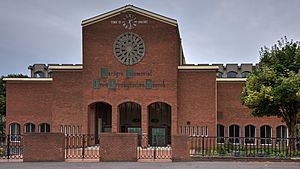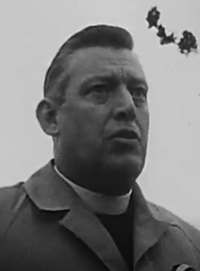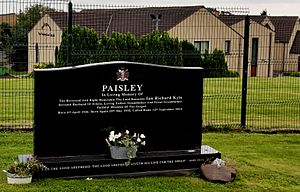Ian Paisley facts for kids
Quick facts for kids
The Lord Bannside
|
|||||||||||||||||||||||||||||||||||||||||||
|---|---|---|---|---|---|---|---|---|---|---|---|---|---|---|---|---|---|---|---|---|---|---|---|---|---|---|---|---|---|---|---|---|---|---|---|---|---|---|---|---|---|---|---|
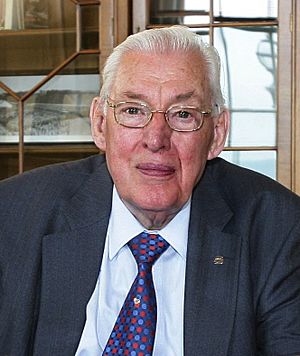
Paisley in 2008
|
|||||||||||||||||||||||||||||||||||||||||||
| First Minister of Northern Ireland | |||||||||||||||||||||||||||||||||||||||||||
| In office 8 May 2007 – 5 June 2008 Serving with Martin McGuinness
|
|||||||||||||||||||||||||||||||||||||||||||
| Preceded by | David Trimble (2002) | ||||||||||||||||||||||||||||||||||||||||||
| Succeeded by | Peter Robinson | ||||||||||||||||||||||||||||||||||||||||||
| Leader of the Democratic Unionist Party | |||||||||||||||||||||||||||||||||||||||||||
| In office 30 September 1971 – 31 May 2008 |
|||||||||||||||||||||||||||||||||||||||||||
| Deputy |
|
||||||||||||||||||||||||||||||||||||||||||
| Preceded by | Party established | ||||||||||||||||||||||||||||||||||||||||||
| Succeeded by | Peter Robinson | ||||||||||||||||||||||||||||||||||||||||||
|
|||||||||||||||||||||||||||||||||||||||||||
| Personal details | |||||||||||||||||||||||||||||||||||||||||||
| Born |
Ian Richard Kyle Paisley
6 April 1926 Armagh, Northern Ireland |
||||||||||||||||||||||||||||||||||||||||||
| Died | 12 September 2014 (aged 88) Belfast, Northern Ireland |
||||||||||||||||||||||||||||||||||||||||||
| Resting place | Ballygowan, County Down | ||||||||||||||||||||||||||||||||||||||||||
| Nationality | British | ||||||||||||||||||||||||||||||||||||||||||
| Political party | DUP (1971–2014) | ||||||||||||||||||||||||||||||||||||||||||
| Other political affiliations |
PUP (1966–1971) | ||||||||||||||||||||||||||||||||||||||||||
| Spouse |
Eileen Cassells
(m. 1956) |
||||||||||||||||||||||||||||||||||||||||||
| Children | 5, including Rhonda and Ian Jr | ||||||||||||||||||||||||||||||||||||||||||
| Alma mater | Barry School of Evangelism | ||||||||||||||||||||||||||||||||||||||||||
| Occupation |
|
||||||||||||||||||||||||||||||||||||||||||
| Profession | Minister | ||||||||||||||||||||||||||||||||||||||||||
Ian Richard Kyle Paisley, also known as Baron Bannside, was a well-known politician and religious leader from Northern Ireland. He was born on 6 April 1926 and passed away on 12 September 2014.
Paisley led the Democratic Unionist Party (DUP) from 1971 to 2008. He also served as the First Minister of Northern Ireland from 2007 to 2008.
He became a Protestant minister in 1946 and continued this role throughout his life. In 1951, he helped start the Free Presbyterian Church of Ulster and was its leader until 2008. Paisley was known for his strong speeches. He often spoke against Catholicism and against different Christian groups working together.
Paisley became involved in politics in the late 1950s. In the 1960s, he led protests against the Catholic civil rights movement. These actions contributed to the start of the Troubles, a long conflict in Northern Ireland. In 1970, he became a Member of Parliament (MP). The next year, he founded the DUP.
During the Troubles, Paisley was seen as a strong voice for unionists. He opposed sharing power between unionists and Irish nationalists. He also opposed the Republic of Ireland having a say in Northern Irish matters. He was against agreements like the Sunningdale Agreement of 1974 and the Anglo-Irish Agreement of 1985. He also opposed the Northern Ireland peace process and the Good Friday Agreement of 1998.
In 2005, Paisley's DUP became the biggest unionist party. In 2007, the DUP finally agreed to share power with the republican party Sinn Féin. Paisley became First Minister, and Sinn Féin's Martin McGuinness became deputy First Minister. He stepped down from these roles in 2008 and left politics in 2011. In 2010, he was given the title of Baron Bannside.
Contents
- Early Life and Family
- Religious Career and Beliefs
- Political Journey and Major Events
- Early Political Activism
- Opposing the Civil Rights Movement
- Forming the DUP and Electoral Success
- Opposing the Sunningdale Agreement
- The 1977 Unionist Action Council Strike
- Becoming a Member of the European Parliament
- The Third Force Movement
- Protesting the Anglo-Irish Agreement
- The Drumcree Dispute
- Opposing the Good Friday Agreement
- Compromise and Power (2000s)
- Final Years and Passing
- Images for kids
- See also
Early Life and Family
Ian Richard Kyle Paisley was born in Armagh, Northern Ireland. He grew up in Ballymena, where his father was a pastor. His mother was from Scotland.
Paisley married Eileen Cassells on 13 October 1956. They had five children: three daughters (Sharon, Rhonda, and Cherith) and twin sons (Kyle and Ian). Some of his children also became involved in politics or religion. Kyle is a minister, Ian is an MP, and Rhonda was a local politician.
Paisley saw himself as an Ulsterman. He also said that "you cannot be an Ulsterman without being an Irishman."
Religious Career and Beliefs
When he was a teenager, Paisley decided to become a Christian minister, like his father. He gave his first sermon at age 16. He studied theology in Wales and Belfast.
In 1951, Paisley helped start the Free Presbyterian Church of Ulster. This happened after a church prevented him from speaking. Paisley became the leader of this new church at just 25 years old. He was re-elected as leader every year for 57 years.
The Free Presbyterian Church is a fundamentalist and evangelical church. It believes in keeping separate from churches that have moved away from core Christian teachings. By 1991, the church had about 12,000 members.
Paisley taught a very traditional form of Christianity. He strongly believed in Biblical literalism and was against Catholicism. He called this "Bible Protestantism." He wrote many books and articles about his religious and political views. In 1966, he started his own newspaper, the Protestant Telegraph, to share his ideas.
Paisley received an honorary degree from Bob Jones University in the US in 1966. This led to the creation of the Free Presbyterian Church of North America. His strong opposition to many things earned him the nickname "Dr. No."
Paisley was known for his strong views against the Pope and the Catholic Church. In 1988, he interrupted a speech by Pope John Paul II in the European Parliament. He shouted "I denounce you as the Antichrist!" and held up a poster. He was then removed from the room.
He believed the European Union was part of a plan to create a Catholic superstate controlled by the Vatican. He even claimed that seat number 666 in the European Parliament was for the Antichrist. After Pope John Paul's death in 2005, Paisley expressed sympathy for Catholics. He said he understood their sorrow and grief.
Political Journey and Major Events
Early Political Activism
In 1949, Paisley became involved in politics. He helped form a Northern Irish branch of the National Union of Protestants. In 1956, he helped found Ulster Protestant Action (UPA). This group aimed to protect Protestant areas from the IRA. The UPA later became the Protestant Unionist Party in 1966.
Paisley gained attention for his strong actions. In 1959, after a UPA rally where he spoke, some Catholic homes and businesses were attacked. In 1964, he threatened to remove an Irish tricolour flag displayed in Belfast. Police removed the flag, leading to serious riots.
Opposing the Civil Rights Movement
In 1964, a peaceful civil rights campaign began in Northern Ireland. This movement wanted to end unfair treatment against Catholics. Paisley led strong opposition to this movement. He also opposed Terence O'Neill, the Prime Minister of Northern Ireland, seeing him as too soft on reforms.
In 1966, Paisley and his colleague Noel Doherty formed the Ulster Constitution Defence Committee (UCDC) and its group, the Ulster Protestant Volunteers (UPV). Around this time, a loyalist group called the "Ulster Volunteer Force" (UVF) emerged. Some of its members were also in the UCDC and UPV. The UVF carried out attacks on Catholic homes and killed two Catholic civilians. These events are sometimes seen as the first deaths of the Troubles. Paisley denied knowing about the UVF's actions.
In June 1966, Paisley led a march against the Presbyterian Church. The march went through a Catholic area, leading to clashes with police and injuries. Paisley was later jailed for organizing an illegal gathering. His supporters protested outside the prison, leading to more unrest.
In 1969, the UPV bombed water and electricity sites in Northern Ireland. Paisley and the UPV blamed the IRA for these attacks. This helped weaken support for Prime Minister O'Neill, who then resigned.
The civil rights campaign and the opposition to it led to the August 1969 riots. These were severe clashes between Catholics, police, and loyalists. British troops were sent in, which many see as the start of the Troubles.
Forming the DUP and Electoral Success
In 1970, Paisley won the Bannside seat in the Northern Ireland Parliament. He also won the North Antrim seat in the UK general election. These wins showed a shift in unionist politics.
On 30 September 1971, Paisley and Desmond Boal founded the Democratic Unionist Party (DUP).
Opposing the Sunningdale Agreement
The Sunningdale Agreement of 1973 aimed to create a new government for Northern Ireland. This government would share power between unionists and nationalists. It also suggested a Council of Ireland to work with the Republic of Ireland. Paisley and other unionists strongly opposed this agreement. They did not want to share power with nationalists. They also saw the Council of Ireland as a step towards a united Ireland.
Paisley, along with other unionist leaders, formed the United Ulster Unionist Council (UUUC) to fight the Agreement. Their slogan was Dublin is just a Sunningdale away. Loyalists also formed the Ulster Workers' Council (UWC) to organize workers against the Agreement.
On 15 May 1974, the UWC called a general strike to bring down the Agreement. This strike lasted 14 days and stopped most activity in Northern Ireland. Loyalist groups helped enforce the strike by blocking roads. On 17 May, bombs were set off in Dublin and Monaghan in the Republic of Ireland. These bombs killed 33 people. The strike led to the collapse of the Sunningdale Agreement on 28 May.
The 1977 Unionist Action Council Strike
In 1977, Paisley was a key figure in the United Unionist Action Council (UUAC). This group organized another general strike on 3 May 1977. The strike aimed to bring back unionist-led government and increase security against the IRA.
This strike was often called "Paisley's strike" because of his big role. Unlike in 1974, many workers did not join, and security forces were better prepared. The strike was called off on 13 May and was seen as a failure. However, Paisley declared it a success and continued his political career.
Becoming a Member of the European Parliament
Paisley was against the European Economic Community (EEC). However, he ran for election to the European Parliament to share his views. In June 1979, he won one of Northern Ireland's seats. He received the most votes of any candidate.
On 17 July, Paisley interrupted the European Parliament's opening to protest that the Union Jack flag was upside down. He also tried to interrupt a speech by the Irish Prime Minister. Paisley easily kept his seat in every European election until he stepped down in 2004.
The Third Force Movement
In 1981, Paisley tried to create a Protestant loyalist volunteer group called the Third Force. This group was meant to work with police and the army against the IRA.
On 6 February 1981, Paisley gathered 500 men on a hillside in County Antrim. They were photographed in military formation. Paisley said, "This is a small token of the men who are placed to devastate any attempt by Margaret Thatcher and Charles Haughey to destroy the Union." He claimed the Third Force had 15,000–20,000 members.
Protesting the Anglo-Irish Agreement
The Anglo-Irish Agreement was signed in 1985 by the British and Irish governments. It stated that Northern Ireland's status would not change without the consent of its people. It also gave the Irish government an advisory role in Northern Ireland.
Paisley and other unionist leaders strongly protested the Agreement. Their campaign was called "Ulster Says No". On 23 November 1985, over 100,000 people attended a rally in Belfast.
In June 1986, Paisley and other politicians occupied the Stormont Parliament Building in protest. They were removed by police. Paisley also helped form the Ulster Resistance Movement (URM) in 1986. This was a loyalist group meant to take "direct action" against the Agreement. The URM later smuggled weapons into Northern Ireland.
The Drumcree Dispute
Paisley was involved in the Drumcree dispute in the 1980s and 1990s. He supported the right of the Orange Order to march through a Catholic area of Portadown. Catholic residents saw these marches as offensive.
In March 1986, a loyalist march was banned from the Catholic area. Paisley led 3,000 loyalists who forced their way through police lines. This led to severe rioting. In July 1995, Paisley was arrested after trying to push through police lines at Drumcree Church. Loyalists blocked roads and attacked Catholics and police. The march was eventually allowed to continue.
Opposing the Good Friday Agreement

Paisley's DUP was initially part of the talks for the Good Friday Agreement in 1998. However, they left when Sinn Féin was allowed to join. Paisley and his party opposed the Agreement in the public vote. Despite their opposition, over 70% of voters in Northern Ireland approved it.
Paisley was elected to the Northern Ireland Assembly created by the Agreement. He kept his seats in the UK and European parliaments. Although his party took seats in the new power-sharing government, DUP ministers refused to attend cabinet meetings because Sinn Féin was involved.
Compromise and Power (2000s)
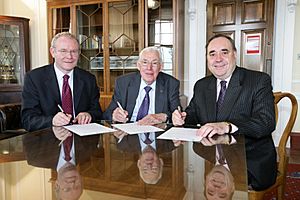
In 2004, Paisley retired from his European Parliament seat. In September 2004, he agreed to meet with Bertie Ahern, the Irish Prime Minister. This was a significant step, as he had long opposed such meetings.
Paisley kept his North Antrim seat in the 2005 UK general election. In 2005, he became a Privy Counsellor. In October 2006, in the St Andrews Agreement, Paisley and the DUP agreed to new elections. They also agreed to support a new government that included Sinn Féin. This was a big change after decades of opposition.
On 8 May 2007, power was returned to Northern Ireland. Paisley and Sinn Féin's Martin McGuinness were elected First Minister and deputy First Minister of Northern Ireland. Paisley said, "Today at long last we are starting upon the road... which I believe will take us to lasting peace." Paisley and McGuinness developed a good working relationship. They were even called the "Chuckle Brothers" by the media.
In 2008, Paisley announced he would step down as DUP leader and First Minister. Peter Robinson took over these roles. In 2010, Paisley announced he would not run for MP again. His son, Ian Paisley Jr., was elected to take his place.
On 18 June 2010, Paisley was made a life peer with the title Baron Bannside. He joined the House of Lords. He chose this title because his wife was already a Baroness, and he wanted his title to be distinct.
Final Years and Passing
In November 2011, Paisley announced his retirement as a minister from his church. He gave his last sermon on 18 December 2011, officially retiring in January 2012 at age 85.
In February 2012, Paisley was hospitalized with heart problems. He had a pacemaker fitted a year earlier. He was hospitalized again in late 2013 for tests.
Paisley passed away in Belfast on 12 September 2014, at 88 years old. He was buried in Ballygowan, County Down, after a private funeral. A public memorial was held in the Ulster Hall in October 2014. Later in his life, Paisley became more moderate in his views towards Catholics.
Images for kids
See also
 In Spanish: Ian Paisley para niños
In Spanish: Ian Paisley para niños


